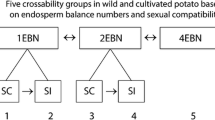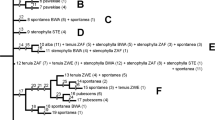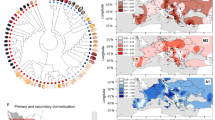Abstract
Cladistic and phenetic analyses of morphological, chloroplast DNA, and isozyme variation were used to examine relationships among multiple accessions of Sphenostylis sten ocarpa, representing wild and cultivated populations from throughout the range of the species. In morphometric and isozyme analyses, greater variability was detected among wild than among cultivated populations, and no differentiation was found between races cultivated for tubers and those cultivated for seeds. cpDNA data, however, revealed five groups of plastomes within S. stenocarpa: one in accessions cultivated for tubers, one in accessions cultivated for seeds, and three among wild accessions. Linguistic evidence and observations on the uses of the species in its two main areas of cultivation suggest independent origins of tuber- and seed- cultivated races. The data support two alternative explanations for the distribution of extant cultivated accessions ofS. stenocarpa. The first hypothesis is that the species was domesticated independently in western and central Africa, but that domestication events involved selection from a single restricted gene pool. The second hypothesis is that a single domestication event occurred in one of the two areas, but that human dispersal to the second area occurred prior to dispersal within either area.
Resumen
Se llevaron a cabo analisis cladísticos y fenéticos de la variación morfológica, del ADN del cloroplasto y de las isoenzimas, para examinar las relaciones entre múltiples especímenes de Sphenostylis stenocarpa, que re presentan poblaciones silvestres y cultivadas de todo el rango de distribución de la especie. En los analisis morfométricos y de isoenzimas, se detectó mayor variabilidad entre las poblaciones silvestres que entre las cultivadas, y no se encontraron diferencias entre las razas cultivadas para tubérculo y las cultivadas para semillas. El ADN del cloroplasto, sin embargo, reveló cinco grupos de plastomas: uno en los especímenes cultivados para tubérculo, uno en los cultivados para semillas, y tres en los silvestres. Por otra parte, evidencias lingüisticas y observaciones de los usos de la especie en sus dos principales areas de cultivo, sugieren un origen independiente de las razas cultivadas para tubérculo y de las cultivadas para semillas. Los datos soportan dos expli caciones alternativas de la distribución de las formas cultivadas existentes de S. stenocarpa. La primera hipótesis es que la especie fue domesticada independientemente en el centro y en el oeste de Africa, pero ambos eventos involucraron selección a partir de un germoplasma único y res tringido. La segunda hipótesis es que hubo un único evento de domesticaciún en una de las dos reas, pero que la dispersión por humanos hacia la segunda rea ocurrió antes que la dispersión dentro de la primera.
Similar content being viewed by others
Literature Cited
Ashton, G. C, and A. W. H. Braden. 1961. Serum β-globulin polymorphism in mice. Austral. J. Biol. Sci. 14: 248–254.
Bretting, P. K., M. M. Goodman, and C. W. Stuber. 1990. Isozymatic variation in Guatemalan races of maize. Amer. J. Bot. 77:211–225.
Broich, S. L., and R. G. Palmer. 1980. A cluster analysis of wild and domesticated soybean phe notypes. Euphytica 29:23–32.
Dalziel, J. M. 1937. The useful plants of West Trop ical Africa. Crown Agents for the Colonies, London.
Doebley, J. F., M. M. Goodman, and C. W. Stuber. 1985. Isozyme variation in races of maize from Mexico. Amer. J. Bot. 72:629–639.
Doyle, J. J. 1988. 5S ribosomal gene variation in the soybean and its progenitor. Theoret. Appl. Genet. 75:621–624.
—,and J. L. Doyle. 1987. A rapid DNA isolation procedure for small quantities of fresh leaf tissue. Phytochem. Bull. 19:11–15.
—,J. L. Doyle., and A. H. D. Brown. 1990. A chlo roplast-DNA phytogeny of the wild perennial rel atives of soybean(Glycine subgenusGlycine): con gruence with morphological and crossing groups. Evolution 44:371–389.
Feinberg, A. P., and B. Vogelstein. 1983. A technique for radiolabeling DNA restriction endonuclease fragments to high specific activity. Anal. Biochem. 132:6–13.
—,and B. Vogelstein. 1984. Addendum:a technique for radiolabeling DNA restriction endonuclease fragments to high specific activity. Anal. Biochem. 137:266–267.
Fivaz, D., and P. E. Scott. 1977. African languages, a genetic and decimalised classification for bibliographic and general reference. G. K. Hall & Co., Boston.
Garvin, D. F., M. L. Roose, and J. G. Waines. 1989. Isozyme genetics and linkage in tepary bean,Pha seolus acutifolius A. Gray. J. Hered. 80:373–376.
Harlan, J. R. 1971. Agricultural origins:centers and noncenters. Science 174:468–474.
—,J. M. J. de Wet, and A. Stemler. 1976. Plant domestication and indigenous African agriculture. Pages 3–19in J. R. Harlan, J. M. J. de Wet, and A. Stemler, eds. Origins of African plant domestica tion. Mouton Publishers, The Hague.
Hennig, W. 1966. Phylogenetic systematics. Uni versity of Illinois Press, Urbana.
Ignart, F., and N. F. Weeden. 1984. Allozyme vari ation in cultivars ofCurcurbita pepo L. Euphytica 33:779–785.
Jain, S. K., L. Wu, and K. R. Vaidya. 1980. Levels of morphological and allozyme variation in Indian amaranths: a striking contrast. J. Hered. 71:283- 285.
Kay, D. E. 1973. Root crops. Tropical Products Institute, London.
Ladin, B. F., J. J. Doyle, and R. N. Beachy. 1984. Molecular characterization of a deletion mutation affecting the alpha-subunit of beta-conglycinin of soybean. J. Molec. Appl. Genet. 2:372–380.
Maniatis, T., E. F. Fritsch, and J. Sambrook. 1982. Molecular cloning, a laboratory manual. Cold Spring Harbor Laboratory, Cold Spring Harbor, NY.
Murdock, G. P. 1959. Africa:its peoples and their culture history. McGraw-Hill, New York.
Myers, J. R., and N. F. Weeden. 1988. A proposed revision of guidelines for genetic analysis inPha seolus vulgaris L. Annu. Rept. Bean Imp. Coop. 31:16–19.
Nei, M. 1972. Genetic distance between populations. Amer. Nat. 106:283–292.
—. 1978. Estimation of average heterozygosity and genetic distance from a small number of in dividuals. Genetics 59:583–590.
Nixon, K. C, and Q. D. Wheeler. 1990. An amplification of the phylogenetic species concept. Cladistics 6:211–223.
Okigbo, B. N. 1973. Introducing the yam beanSphenostylis stenocarpa (Hochst, ex A. Rich.) Harms. Pages 224–238in Proceedings of the first UTA Grain Legume Improvement Workshop. In ternational Institute of Tropical Africa, Ibadan, Nigeria.
Oram, R. N., M. A. Q. Shaikh, K. M. S. Zaman, and A. H. D. Brown. 1987. Isozyme similarity and genetic differences in morphology between Hypro sola, a high yielding, high protein mutant of chick pea(Cicer arietinum L.) and its parental cultivar. Environmental and Experimental Botany 27:455- 462.
Palmer, J. D., R. A. Jorgensen, and W. F. Thompson. 1985. Chloroplast DNA variation and evolution inPisum: patterns of change and phylogenetic anal ysis. Genetics 109:195–213.
Palmer, J. D., and W. F. Thompson. 1981. Clone banks of the mung bean, pea and spinach chloroplast ge nomes. Gene 15:21–26.
Pimentel, R. A., and J. D. Smith. 1986. Biostat II. Sigma Soft, Placentia, California.
Potter, D. 1991. Systematic studies ofSphenostylis andNesphostylis. Ph.D. Dissertation, Cornell Uni versity.
Potter, D.. 1992 Economic botany ofSphenostylis. Econ. Bot. 46:262–275.
Purseglove, J. W. 1976. The origins and migrations of crops in tropical Africa. Pages 291–309in J. R. Harlan, J. M. J. de Wet, and A. Stemler, eds., Or igins of African plant domestication. Mouton Pub lishers, The Hague.
Shaw, T. 1976. Early crops in Africa: A review of evidence. Pages 107–153in J. R. Harlan, J. M. J. de Wet, and A. B. L. Stemler, eds., Origins of Af rican plant domestication. Mouton Publishers, The Hague.
Sneath, P. H. A., and R. R. Sokal. 1973. Numerical taxonomy. W. H. Freeman and Co., San Francisco.
Southern, E. M. 1975. Detection of specific sequenc- es among DNA fragments separated be gel electro phoresis. J. Mol. Biol. 98:503–517.
Stuber, C. W., M. M. Goodman, and F. M. Johnson. 1977. Genetic control and racial variation of β-glu- cosidase isozymes in maize(Zea mays L.) Biochem. Genet. 15:383–394.
Throckmorton, L. H. 1977.Drosophila systematics and biochemical evolution. Ann. Rev. Ecol. Syst. 8:235–254.
Wahl, G. M., M. Stern, and G. R. Stark. 1979. Ef ficient transfer of large DNA fragments from aga rose gels to diazobenzyloxymethyl paper and rapid hybridization by using dextran sulfate. Proc. Natl. Acad. USA 76:3683–3688.
Watrous, L. E., and Q. D. Wheeler. 1981. The out group comparison method of character analysis. Syst. Zool. 30:1–11.
Weeden, N. F. 1984. Distinguishing among white seeded bean cultivars by means of allozyme geno types. Euphytica 33:199–208.
—,J. J. Doyle, and M. Lavin. 1989. Distribution and evolution of a glucosephosphate isomerase du plication in the Leguminosae. Evolution 43:1637- 1651.
Wendel, J. F., and N. F. Weeden. 1989. Genetics of plant isozymes. Pages 46–72in D. E. Soltis and P. S. Soltis, eds., Isozymes in plant biology. Dioscorides Press, Portland, Oregon.
Wheeler, Q. D., and K. C. Nixon. 1990. Another way oflooking at the species problem: a reply to de Queiroz and Donoghue. Cladistics 6:77–81.
Wrigley, C. 1960. Speculations on the economic prehistory of Africa. J. Afr. Hist. 1:189–203.
Zohary, D. 1984. Modes of evolution in plants under domestication. Pages 579–586in W. F. Grant, ed., Plant biosystematics. Academic Press, New York.
Author information
Authors and Affiliations
Additional information
An erratum to this article is available at http://dx.doi.org/10.1007/BF02862027.
Rights and permissions
About this article
Cite this article
Potter, D., Doyle, J.J. Origins of the African Yam bean (Sphenostylis stenocarpa, leguminosae): evidence from morphology, isozymes, chloroplast DNA, and linguistics. Econ Bot 46, 276–292 (1992). https://doi.org/10.1007/BF02866626
Issue Date:
DOI: https://doi.org/10.1007/BF02866626




